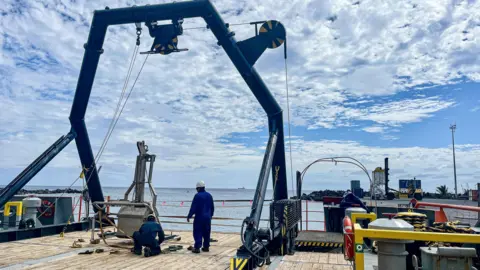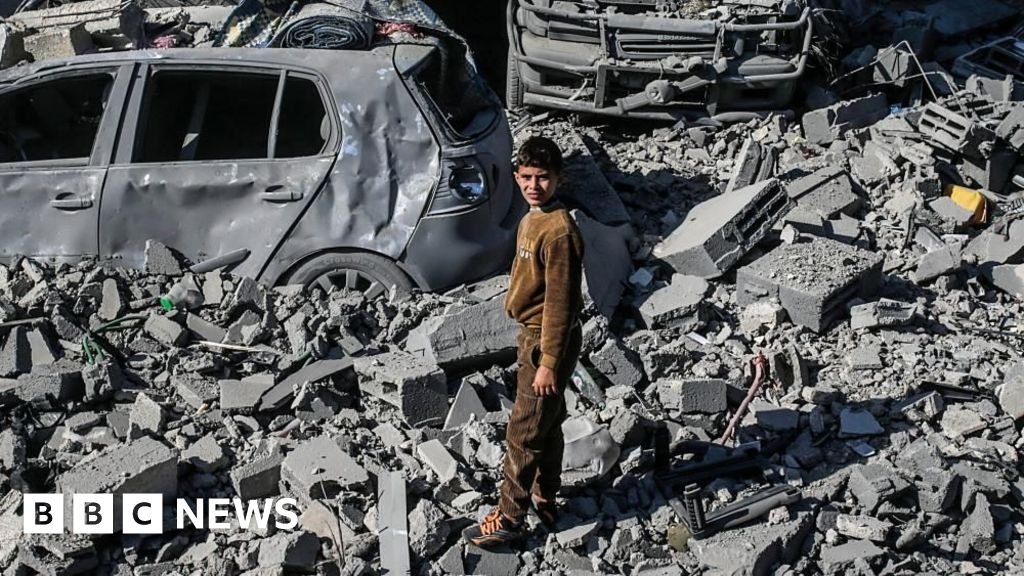Mining the Pacific – future proofing or fool’s gold?

 BBC/Lindle Markwell
BBC/Lindle Markwell“They look like chocolate truffles, just don’t eat them,” jokes Jean Mason, the curator of the Cook Islands Library and Museum as she reaches into a display cabinet and pulls out a black, knobbly rock.
The “rock” she is holding may well determine the future of this Pacific nation.
It is what scientists call a polymetallic nodule, created over millennia as minerals accumulate on the seabed.
Packed full of cobalt, nickel and manganese, these ancient formations are now valuable: the metals go into batteries that power modern life, from electric cars to mobile phones.
They have become a source of friction in the low-lying Pacific Islands, which are among the nations most vulnerable to climate change.
With rising sea levels, the ocean – or Moana, as it’s called in Māori and many other Polynesian languages – remains their greatest threat, but it is also their biggest provider.
They fish in it and they live off the tourists drawn to their turquoise waters, but now the Cook Islands wants to dig deeper, up to 6,000m (19,685 ft), where the nodules lie.
It’s a pet project for Prime Minister Mark Brown, who believes it will reshape this country of 15 volcanic islands in the southern Pacific.
 BBC/Lindle Markwell
BBC/Lindle MarkwellThe hope is that the income from these metals could lead to more prosperity than the islanders had ever imagined.
Except the promise of deep sea mining may carry an environmental price.
Proponents say that harvesting these nodules for use in renewables will help the world transition from fossil fuels. They also believe that it is less invasive than mining on land.
But critics argue so much is still unknown about the impact of extracting what is one of the last untouched parts of the planet. They say there should be a pause on deep sea mining until there is more research on its effects on marine life and the oceanic ecosystem.
When Jean was growing up, she says, the nodules were only thought to be useful for making knife blades.
“We had no idea that cell phones were going to come, and wind turbines and electric cars.”
Nodules are a family conversation here and Jean is firmly in favour of mining them. Her husband is a lawyer for one of the companies given exploration licences by the government.
The library where she works is stacked full of holiday reads left or donated by tourists – tourism is the country’s biggest earner, accounting for more than 70% of its GDP.
It includes a newspaper archive.
Jean shoves a photocopy of an article from the Cook Islands News into my hand. It’s from 1974 and the headline reads “100% concentration of manganese nodules”.
“My point is, we’ve been talking about this for 50-plus years – I think the moratorium time is over.”
The gold in the oceans
The Pacific Ocean covers close to a third of the planet. And the nodules buried in it have been known about since the 19th Century.
But in the 1960s, American geologist John L Mero published a book setting out the case that the seabed could provide many of the world’s mineral needs.
It’s not an easy process – nor a cheap one. But when prices of metals like nickel soared in 2008, it looked more appealing.
Then Covid hit. Tourists left and the money dried up.
Together with the impact of climate change – rising sea levels and unpredictable weather patterns – the country quickly realised it needed something else to rely on.
The Cook Islands’ Seabeds Minerals Authority estimates there are 12 billion wet tonnes of polymetallic nodules in their waters.
Some people argue mining the seabed is not financially viable. With technology moving so fast, these metals may not even be in demand by the time it gets going.
But there are takers. And in 2022, the Cook Islands gave out three licences to companies to start exploring the possibility of deep-sea mining.
They’re now working with scientists in researching the environmental impact.
 BBC/Lindle Markwell
BBC/Lindle Markwell“Nothing we do in life is risk-free. So, if you want zero risk you need to go and sit in a little room with cotton wool around you,” says Hans Smit, who runs Moana Minerals, one of the firms that has an exploration licence.
“We have this lifestyle, this lifestyle has a price. If we don’t want mining and we don’t want to get all these metals, we need to stop doing just about everything we’re doing.”
Hans is from South Africa and moved here to be part of the community. To him, the deep-sea metals are an “incredible resource” that could benefit the islanders.
While there’s a growing call to delay deep-sea mining until regulations by the International Seabed Authority are drawn up, this only applies to international waters.
The Cook Islands still have huge reserves of their own in their national waters – their Exclusive Economic Zone (EEZ) – so, they can crack on regardless.
“We’re known as small-island developing states, but we like to call ourselves large ocean states,” says Rima Brown, a young Cook Islander with a geography degree who jokingly calls herself the poster child for deep-sea mining.
Rima works for the Seabed Minerals Authority and much of her time is spent mapping the sea bed.
“While we’re only about 200 square kilometers in land mass, we have an exclusive economic zone of almost 2 million square kilometres,” she says.
That’s the equivalent of Mexico.
“It’s the only resource we’ve got,” Jean says.
“[Industrialised nations] destroy our atmosphere and then they’ve got a nerve to tell us, let’s leave your stuff in the seabed. How dare they tell us we can’t touch our resources?”
But it’s not just outsiders who are opposed to deep-sea mining in the Cook Islands.
Future proofing or a fatal error?
Off the coast of Rarotonga, the largest and most populous of the Cook Islands, a crowd of surfers, kayakers and swimmers gather around a large vaka, a traditional Polynesian catamaran.
“Te Moana, Te Moana, Paruru ia ra, Paruru ia ra,” the people on board repeat – “Protect our ocean”, they are chanting in Māori.
“We are asking for more time for robust independent research, more time for our people to be made better aware of what potential risk might look like,” says Alanah Matamaru Smith from the Te Ipukarea Society, an environmental organisation based in Rarotonga.
“We’re seeing infrastructure being put up here on Rarotonga, accommodation for offshore mining companies to reside here, we’ve got draft mining regulations already in place. Actions are speaking a lot louder than words at the moment.”
 BBC/Lindle Markwell
BBC/Lindle MarkwellPrime Minister Mark Brown, who is driving this, also happens to be the tourism minister and the seabed minerals minister. He’s made it clear he wants the Cook Islands to be a leader in the industry.
“It provides the opportunity for our kids to be able to study at any university in the world without having to incur a student loan,” says Brown, who has a vision of following the lead of Norway in establishing a sovereign wealth fund.
“It allows us to have the type of health care that our people have to go to New Zealand or Australia for. It allows our young people the opportunity to live fulfilling lives here in our country, without having to go to other countries to ply their trade in an industry that doesn’t exist here.”
To those who say a country threatened by climate change risks becoming part of the problem, he argues he’s trying to find solutions.
“We know that for the last 20 years we haven’t been able to get the financing from the larger emitting countries, so we’ve got to look for ways to protect ourselves.”
But activist June Hosking isn’t convinced.
She’s from one of the outer islands, Mauke, with a population of just 300 people.
While the government has organised consultations with residents across the islands as well as the large diaspora in New Zealand, she says the potential downsides of the industry are not being discussed.
“People don’t like to rock the boat in the outer islands,” she says. “So, when we have these consultations, there’s only maybe three of us who would speak up.”
June says such is island life, many refer to the PM as just Mark. She also says his wife is married to her husband’s cousin.
But family connections don’t stop her being seen as a bit of a trouble-maker in asking questions.
“When locals say ‘Oh no, I stay neutral on [deep-sea mining]’, I say ‘you can’t drive very far in neutral’,” she laughs.
“There are times in your life when you need to actually make a stand for something – we are talking about our future here.”
Additional reporting by Lindle Markwell.
You can listen to Katy Watson’s documentary from the Cook Islands on Assignment on the BBC World Service Radio.
https://ichef.bbci.co.uk/news/1024/branded_news/1dcb/live/ef9ba600-b60d-11ef-a785-23eacc5a1119.jpg
2024-12-09 22:57:01






